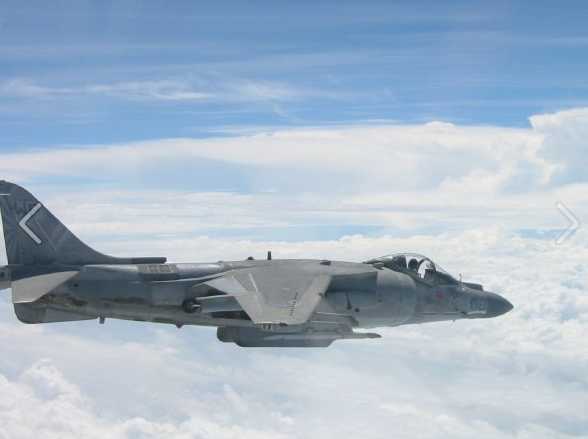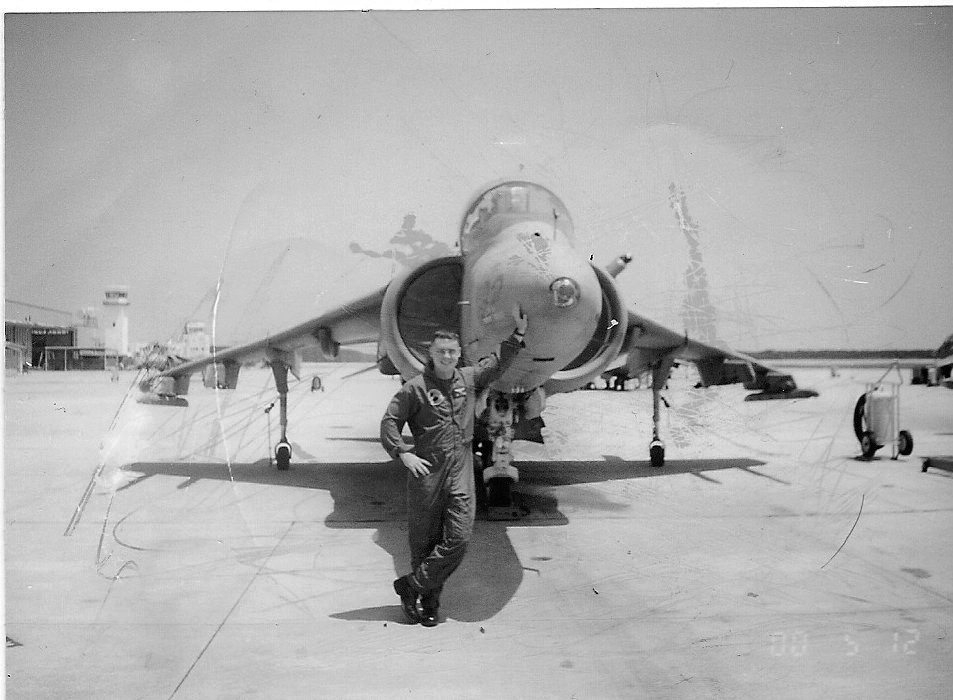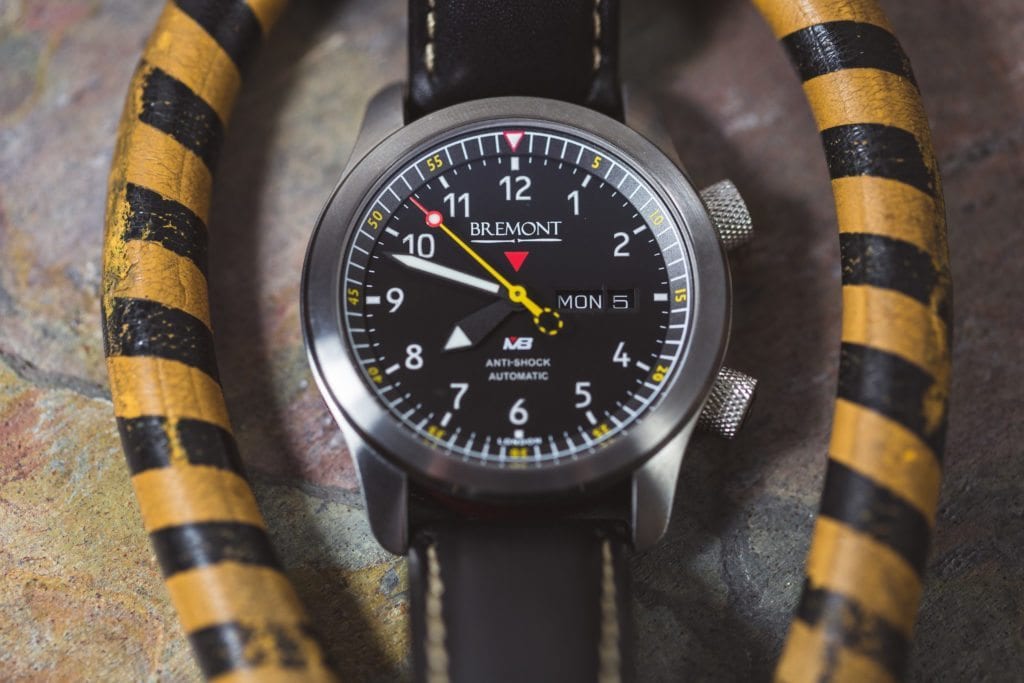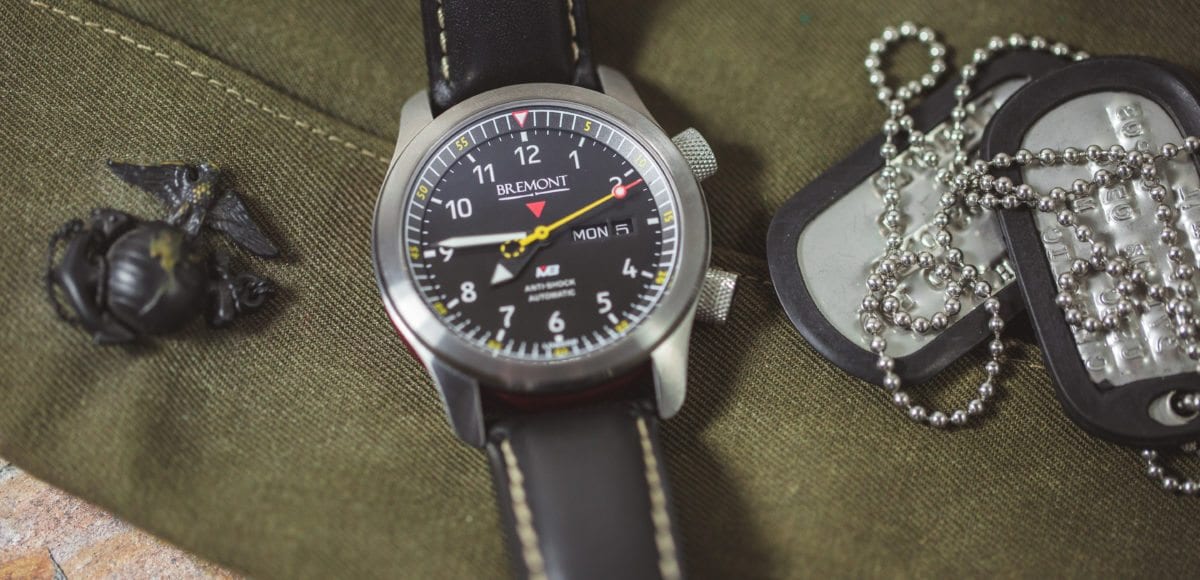On March 4, 2008 on a rainy day in Mississippi, Jim Bernthal became a part of a club he never intended to join. A Marine Corps flight instructor, Jim was scheduled to give training in a T-45 Goshawk, a single-engine tandem-seat fighter. Though he and his co-pilot received clearance to take off in bad weather and the flight was uneventful, the landing was a whole other story. On that day, the pilots narrowly survived, and Jim got his unwanted admittance into the ejection club.
We recently had the opportunity to talk to Jim about his life, his ejection, and of course, his watch. His story is incredible, and embodies the courage and fearlessness of our military.
Jim Bernthal: Background
But first, a little background on Bernthal. He is a husband, father to five boys, and was a Marine Corps pilot. He is one of very few pilots to have instructed primary, intermediate, and advanced tactical jet students. Due to this, he has taken students from their very first flights to the moment they earn their wings. He is an Operation Iraqi Freedom veteran and runs a nonprofit for young leaders called SALTE. This stands for Student Athlete Leader Training and Education which gives leadership training and courses that include goal achievement and team building to young athletes. He also is also currently working on his PhD in industrial and organizational psychology.

Jim Bernthal standing in front of a T-45
Jim tells us he considers himself a religious and spiritual man. A lifelong Catholic, he prays the rosary regularly and says that one of its promises are signal graces, or signs. He says that he has never really been able to decipher any signs, nor asks for them, but that in retrospect he can see they were there on two particular occasions. The first time, he woke up one morning and felt uneasy. Stationed in Pensacola, he had two training flights scheduled that morning. Despite the unease he headed into work. The flights were fine, but he tore his Achilles later that day during a base soccer team tryout.
March 4, 2008: The Flight
He says that looking back, the second time he felt that way was on March 4, 2008. This time with the VT-9 training squadron at Naval Air Station Meridian in Mississippi. He got up at 5 a.m. to prepare for that day’s flights and had the same ominous feeling he had previously experienced in Pensacola. He says he thought of “canceling from the rack” which to the lay person just means calling in from bed.
The weather was bad enough that day that he thought the flights would be grounded, but he was flying with one of his best students. So, he pushed the eerie feelings aside and went in. Prior to take-off he looked over at the landing runway and it was covered in fog, so he called in to have a legal divert (backup plan) in case the fog hadn’t cleared when they broke through cloud cover during their descent. The flight was on, and he, his co-pilot and another plane took to the sky.

Here Jim begins going over some of the more technical aspects of his flight and the plane itself. He talks about the T-45 he was flying that day and how it can pull 7 to 8 G’s (g- force) and what that force does to a person’s body. The physics are astounding and somewhat frightening. Words like gun sight tracking, rendezvous, and “tact form” (tactical formation) are used.
He says that the plan was to get in the sky and meet out with another plane at a specific point with 1000-foot separation. This means that the planes are 1000 feet apart in altitude and only have a mile of separation between them. For reference, these planes can go over 600 miles per hour, so this is no easy feat. It’s here that the intricacies and hazards of his job become completely apparent. It takes an incredible amount of precision, skill, and knowledge to pilot as one mistake could be expensive and deadly.

Despite the weather, Jim and his student had a great flight and accomplished their goals. The planes split apart to land, and Bernthal and his co-pilot began their descent. The descent was easy, and the plane touched down. This is where things started to fall apart. Jim noticed that his co-pilot picked up a little bit of a drift during the landing, but said it “didn’t bother me, because I knew he could control it in the cross-wind.” However, they started going off the runway. Initially, Bernthal thought that his co-pilot had made a serious error and he took the controls. The student said, “It’s not me, sir” and Jim quickly realized that the plane itself may have an issue. Jim was able to get them airborne again, declared an emergency and asked for LSO (Landing Safety Officer) assistance.
The Plane Crash
While they were rounding up an LSO, the plane was running low on fuel. They were still in landing pattern, but the visibility was poor, and they were desperately trying to keep their eyes on the runway while troubleshooting the plane. So, they tried to land again. He lowered the landing gear, re-did the appropriate checks, and began to their descent.
Due to a perfect storm of the plane’s problems, braking issues, and environmental factors, the plane was heading for a crash. Essentially, though the plane had touched down, it “thought it” was still in the air. Bernthal could no longer center the throttle and pull it back to gain altitude again, and forest is all that would meet them at the end of the runway. Jim says he had this moment where he “felt the hand of God” and a voice in his heart said, “live or die.” and knew what it meant. So, Bernthal pulled the handle, and the pilots ejected.

Ejecting on the ground is one of the most dangerous types and the force of an ejection causes one in three pilots to break their backs. Jim was the one in three. His co-pilot sustained no injuries. As Bernthal was ejecting he says he wondered if he would see his wife and children again (at the time he only had three). Once he felt the separation from his seat, and his parachute opened, he knew he would live and could handle whatever other injuries he had. For him, this included the removal of lead from his eyes. Jim lived, and can walk, but still suffers the effects of the trauma to his body.

The T-45 Crash Site
After the Ejection
For many, an ejection would be distressing enough to warrant never flying, let alone piloting again. Jim, however, persevered and received clearance to fly again with A1 status. This clearance meant that he was not only capable of handling the rigors of flight, but that the military found him at no-fault during the accident. He piloted ten more times, but realized that the lasting effects of the ejection on his body were too much and he couldn’t continue flying.

Though Bernthal is no longer in the military, it is apparent that it is in an engrained part of who he is. He is still a teacher, and now, a student. Post-military he earned his Masters and is currently working towards his PhD. During his Masters study, he was profiling Dr. Martin Luther King Jr. and stumbled across a video. In it he kept seeing the phrase “march for” written on many of the activist’s homemade signs. For King and his supporters, it was a march for equality, for equal pay, and for civil rights. For Bernthal, this video was another sign. He ejected on March 4th and for him the “march for” was a reminder that he too needed to march forward. This is his new mantra.
The ejection club has quite an initiation, and a lifelong membership. Members of the club don’t get much, but they have their stories, their enduring physical hardships, and a camaraderie amongst each other. They have also earned a special watch.
The Bremont MBI: The Ejection Watch
Bremont, in partnership with Martin-Baker (a manufacturer of 70% of the world’s ejection seats), have created a definitive aviation watch. This watch, first released in 2009, not only had to look good, but had to be functional. It needed to withstand the same rigorous testing as a Martin-Baker ejection seat. From this, the MBI was born.

The MBI is a limited-edition timepiece that is only available to pilots who have ejected using a Martin-Baker seat. It has a black dial, and a stainless-steel case with a distinct red aluminum barrel. The watch has luminous white markers and the seconds hand is an ejection handle.

The MBI is a chronometer and water-resistant to 100m. It features an anti-shock case mount and an anti-magnetics Faraday cage protects the movement inside. It is a fitting tribute the pilots who have had to pull the handle.
Jim Bernthal: What He’s Doing Now
For Jim, this watch is a tangible piece of his story. It has his ejection number and date engraved on the caseback, and is an interesting piece of his military collection. He has only worn it a few times and only on his ejection anniversary. With five sons, he doesn’t know who he would pass it to, and feels like the watch could do some good. So, he’s letting it go. With its sale, he hopes that he can help finish out his PhD and have a decent nest egg to get his boys through school. However, Bernthal, in true military style, is thinking of others and intends to give a part of the proceeds of his watch to a nonprofit crisis pregnancy center.

Now Jim lives in North Carolina with his wife and five boys. They range in age from single digits to college and Jim talks about them with pride and love. He loves mentoring youth and feels a responsibility to help others. He uses his story, military training, and lessons to inspire and connect with others, teaching them to lead with courage, and keep marching forward.
Read other Watch Stories like Pete Servold, from Pete’s Paleo.
Get More Articles Like This in Your Inbox
We're constantly creating great content like this. So, why not get it delivered directly to your inbox? By subscribing you agree to our Privacy Policy but you can unsubscribe at any time.






